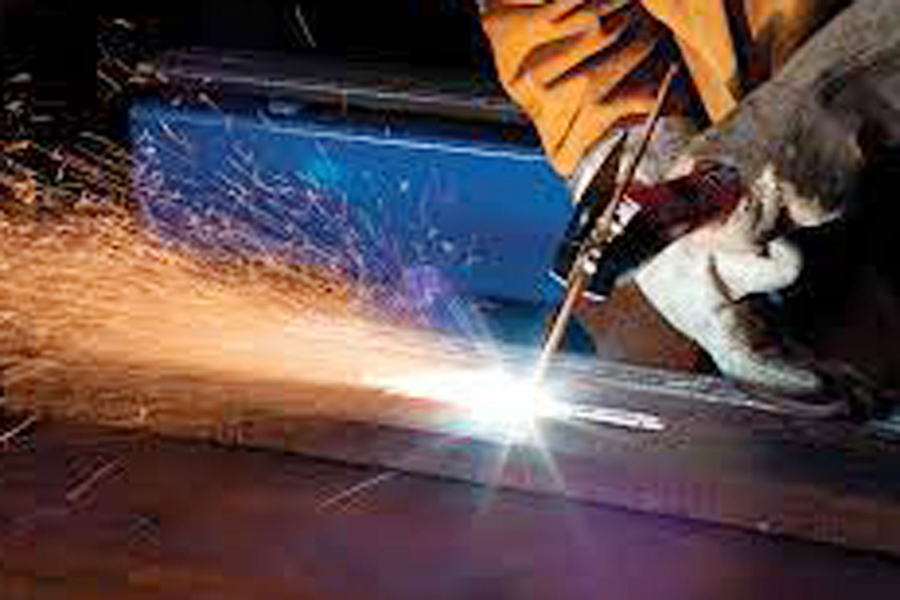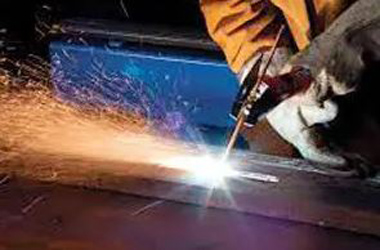Are you curious about arc gouging with a stick welder? Look no further! In this article, we will explore the ins and outs of this fascinating welding technique. Whether you’re an experienced professional or just starting out in the world of welding, understanding arc gouging can greatly enhance your skill set.

What is a Stick Welder?
A stick welder, also known as a shielded metal arc welder (SMAW), is a versatile welding machine that utilizes a consumable electrode coated in flux to create an electric arc. This arc generates enough heat to melt the electrode and the base metal, creating a fusion that forms a strong weld joint. Stick welders are commonly used in various industries due to their simplicity, portability, and ability to work in challenging environments.
Arc gouging, sometimes referred to as air carbon arc gouging, is a technique that utilizes the intense heat of the electric arc produced by a stick welder to remove metal from a workpiece. Unlike other cutting methods, arc gouging is highly efficient and can be used on a wide range of materials, including steel, stainless steel, cast iron, and non-ferrous metals. This makes it an indispensable process in industries such as metal fabrication, shipbuilding, and pipeline maintenance.
Arc Gouging Process
Arc gouging involves creating an electric arc between the tip of the electrode and the workpiece. As the arc is established, a powerful jet of compressed air blows away the molten metal, creating a groove or cavity. The process can be controlled by adjusting the arc length, travel speed, and air pressure.
One of the key advantages of arc gouging is its ability to remove metal quickly and efficiently. The intense heat generated by the electric arc rapidly melts the metal, while the force of the compressed air blows it away, resulting in a smooth and clean cut. This makes arc gouging a preferred method for preparing surfaces for welding, removing defects, and repairing damaged parts.
Benefits of Using a Stick Welder for Arc Gouging
Arc gouging with a stick welder offers several advantages over other cutting methods. Firstly, stick welders are widely available and relatively affordable, making them a cost-effective option for arc gouging. Additionally, stick welders are portable, allowing you to perform arc gouging in remote locations or confined spaces.
Another benefit of using a stick welder for arc gouging is the versatility it offers. Stick welders can be used with various electrode types, allowing you to adapt to different materials and applications. Whether you need to remove a small amount of metal or create a deep groove, a stick welder can handle the task with precision and efficiency.
Safety Precautions for Arc Gouging with Stick Welder
As with any welding process, safety should be a top priority when performing arc gouging with a stick welder. Here are some essential safety precautions to keep in mind:
- Protective Gear: Always wear appropriate personal protective equipment (PPE) such as a welding helmet, safety glasses, gloves, and flame-resistant clothing to shield yourself from sparks, heat, and UV radiation.
- Ventilation: Ensure that the work area is well-ventilated to prevent the accumulation of harmful fumes and gases produced during the arc gouging process. If working indoors, use exhaust fans or other ventilation systems to maintain clean air.
- Fire Prevention: Remove any flammable materials from the work area and have a fire extinguisher nearby. Sparks and molten metal can cause fires, so it’s crucial to be prepared.
- Electrical Safety: Before starting arc gouging, inspect the welding machine and cables for any damage. Ensure that the machine is properly grounded to prevent electrical shocks.
- Training and Certification: Obtain proper training and certification in arc gouging techniques to ensure you have the necessary skills and knowledge to perform the process safely.
By following these safety precautions, you can minimize the risk of accidents and create a safe working environment for arc gouging.
Choosing the Right Electrodes for Arc Gouging
The choice of electrode plays a crucial role in the success of arc gouging. Different electrode types offer varying characteristics and performance, allowing you to optimize the process for specific applications. Here are some commonly used electrodes for arc gouging:
- Copper-coated Carbon Electrodes: These electrodes are widely used for general-purpose arc gouging. They provide good metal removal rates and are suitable for a variety of materials.
- Copper-coated Graphite Electrodes: Graphite electrodes are known for their excellent metal removal rates and long life. They are particularly effective for gouging hard and tough materials.
- Copper-coated Copper Electrodes: Copper electrodes are preferred for applications where minimal base metal dilution is desired. They deliver precise and controlled gouging with minimal sparking.
- Exothermic Electrodes: Exothermic electrodes are unique as they generate their own oxygen during the arc gouging process. This eliminates the need for an external air supply and makes them ideal for remote or confined space applications.
When selecting an electrode, consider factors such as the material being gouged, desired metal removal rate, surface finish requirements, and electrode life. Experimenting with different electrode types will help you determine the most suitable option for your specific arc gouging needs.
Techniques for Effective Arc Gouging with a Stick Welder
Mastering the techniques of arc gouging is essential to achieve optimal results. Here are some tips to improve your arc gouging skills:
Maintain Consistent Arc Length
Keep the distance between the electrode tip and the workpiece consistent throughout the gouging process. This ensures a stable arc and helps control the depth and width of the groove.
Control Travel Speed
Adjust your travel speed to achieve the desired metal removal rate. Moving too quickly may result in insufficient metal removal, while moving too slowly can lead to excessive heat buildup and potential damage to the workpiece.
Angle of Electrode
Position the electrode at a slight angle (approximately 15-20 degrees) to the workpiece surface. This helps direct the molten metal away from the electrode, preventing it from sticking and causing defects.
Overlap Technique
Utilize an overlap technique by slightly overlapping each pass to ensure consistent and even metal removal. This helps create a smooth and uniform groove.
Practice and Patience
Arc gouging requires practice to develop the necessary skill and hand-eye coordination. Be patient and keep refining your technique to achieve the desired results.
By implementing these techniques, you can enhance your arc gouging capabilities, resulting in cleaner and more precise cuts.
Common Mistakes to Avoid During Arc Gouging
Even experienced welders can make mistakes during arc gouging. Here are some common errors to watch out for:
Inconsistent Arc Length
Maintaining a consistent arc length is crucial for achieving uniform metal removal. Fluctuations in the arc length can result in uneven gouging and an inferior surface finish.
Excessive Heat Input
Applying too much heat during arc gouging can lead to distortion, warping, or melting of the workpiece. It is essential to strike a balance between metal removal and avoiding excessive heat input.
Improper Electrode Angle
Holding the electrode at the wrong angle can cause the molten metal to stick to the electrode, resulting in poor gouging performance and defects in the groove.
Inadequate Travel Speed
Moving too slowly can lead to excessive heat buildup, while moving too quickly may result in insufficient metal removal. Finding the optimal travel speed is key to achieving the desired results.
Neglecting Surface Preparation
Proper surface preparation is essential for successful arc gouging. Ensure that the workpiece is clean, free from contaminants, and properly secured to avoid movement during gouging.
By being aware of these common mistakes, you can avoid them and produce high-quality gouged surfaces.
Maintenance and Care for Stick Welders Used for Arc Gouging
Regular maintenance and care of your stick welder are essential to ensure its longevity and optimal performance. Here are some tips to keep your stick welder in top shape:
Cleanliness
Regularly clean the stick welder and remove any debris, dust, or spatter that may accumulate on the machine. This helps prevent damage to internal components and ensures efficient operation.
Electrode Holder Maintenance
Inspect the electrode holder for any signs of wear or damage. Replace worn or damaged parts promptly to maintain a secure connection between the electrode and the machine.
Electrode Storage
Properly store electrodes in a dry and moisture-free environment to prevent degradation of their coating. Moisture can affect the performance of the electrode and lead to unreliable arc gouging.
Inspection and Calibration
Periodically inspect and calibrate the stick welder to ensure accurate settings and readings. This helps maintain consistent performance and ensures the safety of the operator.
Professional Servicing
If you encounter any issues or suspect a problem with your stick welder, consult a professional technician or contact the manufacturer for assistance. Attempting repairs without proper knowledge and expertise can result in further damage.
By following these maintenance practices, you can prolong the lifespan of your stick welder and ensure it remains in optimal condition for arc gouging.
Conclusion and Final Thoughts
Arc gouging with a stick welder is a valuable skill that can greatly enhance your welding capabilities. Whether you’re looking to remove unwanted material, prepare surfaces for welding, or repair damaged parts, arc gouging offers a versatile and efficient solution.
In this article, we explored the equipment required, techniques to master, safety precautions, electrode selection, and maintenance tips for arc gouging with a stick welder. By understanding the ins and outs of this specialized welding process, you can confidently tackle various applications and achieve exceptional results.
So, whether you are a seasoned welder looking to expand your skill set or a beginner eager to learn something new, arc gouging with a stick welder is a technique worth exploring. Take the time to practice, hone your techniques, and always prioritize safety. With dedication and perseverance, you can become proficient in arc gouging and elevate your welding expertise to new heights. Happy gouging!
